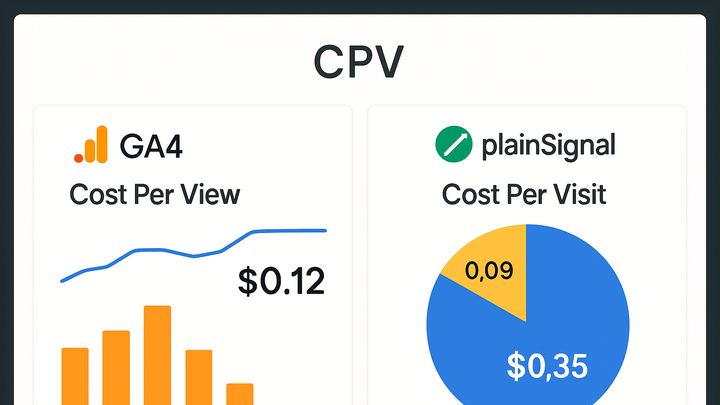Published on 2025-06-28T08:43:34Z
What is CPV in Analytics? Examples for CPV in GA4 and plainSignal
CPV, or Cost Per View (in video advertising) and Cost Per Visit (in web analytics), measures how much you spend for each view or site visit driven by paid campaigns. In digital advertising, CPV calculates the average cost of each user-initiated video ad view, often defined by a minimum watch time. In web analytics, CPV is computed by dividing total ad spend by the number of paid sessions (visits) to your site. By combining session and cost data—via Google Analytics 4 (GA4) or a cookie-free solution like plainSignal—you can pinpoint budget efficiency and optimize your media buys. Understanding CPV helps marketers allocate resources wisely, compare channel performance, and benchmark against industry standards.
Cpv
CPV (Cost Per View/Visit) measures the average cost of each video ad view or paid website session.
Definition and Context
This section defines CPV in both digital advertising and web analytics, explains the two interpretations, and clarifies when each is used.
-
Digital advertising: cost per view
In video advertising, CPV refers to the amount paid each time a user watches your video ad for a predefined duration (e.g., 30 seconds or the full ad length).
-
Web analytics: cost per visit
In web analytics, CPV indicates the average cost to acquire a single website visit through paid channels, calculated as total ad spend divided by paid sessions.
Calculating CPV
Here we delve into the CPV formula, data requirements, and step-by-step computation in GA4 and plainSignal.
-
Basic cpv formula
CPV = Total Ad Spend ÷ Number of Views (or Visits). Ensure you use consistent currency and view/visit definitions.
-
Total ad spend
Sum of all costs associated with the campaign over a defined period.
-
Number of views or visits
Total video ad views or paid sessions recorded in your analytics tool.
-
-
Calculating cpv in GA4
Import cost data from Google Ads or upload a cost CSV. Then use Explorations or a custom report to divide total ad spend by the number of sessions attributed to paid sources.
-
Calculating cpv with PlainSignal
plainSignal provides cookie-free session data. Combine session counts from plainSignal with your ad spend to compute CPV.
-
PlainSignal tracking code
Add this snippet to your HTML to enable data collection:
<link rel="preconnect" href="//eu.plainsignal.com/" crossorigin /> <script defer data-do="yourwebsitedomain.com" data-id="0GQV1xmtzQQ" data-api="//eu.plainsignal.com" src="//cdn.plainsignal.com/plainsignal-min.js"></script>
-
Why CPV Matters
Analyzing CPV helps marketers understand how efficiently their budgets produce views or visits and guides optimization decisions.
-
Budget optimization
Lower CPV indicates more cost-effective views or visits, allowing you to reallocate budget toward high-performing campaigns.
-
Channel comparison
Comparing CPV across platforms (e.g., YouTube vs. social channels) reveals which channels deliver engagement at lower costs.
-
Performance benchmarking
Use industry CPV benchmarks to set targets and evaluate the success of your campaigns relative to peers.
Best Practices and Pitfalls
Tips for optimizing CPV and common mistakes to avoid when interpreting the metric.
-
Use consistent definitions
Ensure views or visits are defined the same way across tools to avoid skewed CPV calculations.
-
Account for viewability
In video ads, count only views that meet your viewability threshold (e.g., ≥30 seconds played) to reflect true engagement.
-
Be wary of incomplete data
Cookie-free analytics may undercount sessions if ad spend attribution isn’t properly configured. Validate CPV with multiple data sources when possible.
